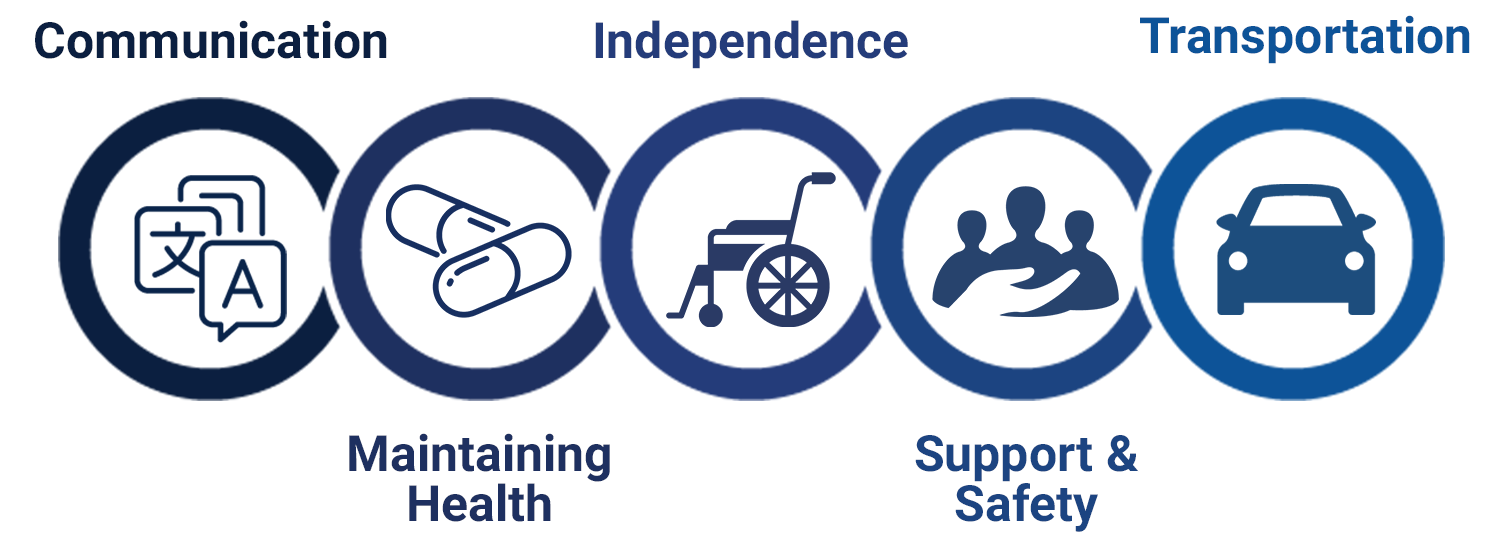At-Risk Individuals with Access and Functional Needs
At-risk individuals are people with access and functional needs (AFN) (temporary or permanent) that may interfere with their ability to access or receive medical care before, during, or after a disaster or public health emergency. Irrespective of specific diagnosis, status, or label, the term access and functional needs is used to describe a broad set of common and crosscutting access and functional needs.
- Access-based needs require that resources are accessible to all individuals, such as social services, accommodations, information, transportation, medications to maintain health, and so on.
- Function-based needs refer to restrictions or limitations an individual may have that requires assistance before, during, and/or after a disaster or public health emergency.
The 2019 Pandemic and All-Hazards Preparedness and Advancing Innovation Act requires taking into account the public health and medical needs of at-risk individuals. It defines at-risk individuals as children, pregnant women, older adults, individuals with disabilities, or others who may have access or functional needs in the event of a public health emergency, as determined by the Secretary of Health and Human Services. Examples of other populations may include but are not limited to individuals from diverse cultures, individuals who have limited English proficiency or are non-English speaking, individuals who are transportation disadvantaged, individuals experiencing homelessness, individuals who have chronic health conditions, and individuals who have pharmacological dependency.
At-risk individuals may have a number of additional needs that must be considered in planning for, responding to, and recovering from a disaster or public health emergency. The CMIST Framework is a recommended approach for integrating the AFN of these individuals. CMIST is an acronym for the following five categories: Communication, Maintaining health, Independence, Support and Safety, and Transportation. The CMIST Framework provides a flexible, crosscutting approach for planning to address a broad set of common AFN without having to define a specific diagnosis, status, or label.
The framework is an acronym composed of five categories as follows:

Communication
Individuals who speak sign language, who have limited English proficiency (LEP), or who have limited ability to speak, see, hear, or understand
People with communication needs may have limited ability to hear announcements, see signs, understand messages, or verbalize their concerns.
Maintaining Health
Individuals who may require specific medications, supplies, services, durable medical equipment, electricity for life-maintaining equipment, breastfeeding and infant/childcare, or nutrition, etc.
Early identification and planning for AFN can help to reduce the negative impacts of a disaster on individuals’ health. This includes:
- Maintaining chronic health conditions
- Minimizing preventable medical conditions
- Avoiding decompensation or worsening of an individual’s health status
Independence
Individuals who function independently with assistance from mobility devices or assistive technology, vision and communication aids, services animals, etc.
Independence is the outcome of ensuring that a person’s access and functional needs are addressed as long as they are not separated from their devices, assistive technology, service animals, etc.
Support and Safety
Some individuals may become separated from caregivers and need additional personal care assistance; experience higher levels of distress and need support for anxiety, psychological, or behavioral health needs; or require a trauma-informed approach or support for personal safety.
Early identification and planning for AFN can help to reduce the negative impacts of a disaster on individuals’ wellbeing. Some people may have lost caregiver assistance and require additional support; some individuals may find it difficult to cope in a new or strange environment or have difficulty understanding or remembering; and some individuals may have experienced trauma or be victims of abuse.
Transportation
Individuals who lack access to personal transportation, are unable to drive due to decreased or impaired mobility that may come with age and/or disability, temporary conditions, injury, or legal restriction.
Disasters can significantly reduce transportation options, inhibiting individuals from accessing services, staying connected, etc. Disaster planning requires coordination with mass transit and accessible transportation services providers.
Learn More
Addressing AFN is a crucial part of comprehensive disaster planning for the whole community and is mandated for inclusion in federal, state, local, tribal, and territorial public health emergency plans. To learn more about addressing the AFN of individuals and the CMIST Framework, you may take the free HHS/ASPR Access and Functional Needs Web-Based Training.

